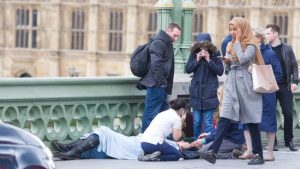Current responses seem to normalise terrorism – cementing it into the everyday reality of daily life, in the same way that we accept poverty, homelessness or inequality. The way things are, like reported by opendemocracy.net
So, once again, we face a terrorist attack in the western world. And moreover, not only do we face the reality of the bloodshed, the violence and the affront we all feel in the sense of a violation of security, we also face the need to respond. Each time these attacks take place, whether in Brussels, Paris or London (but perhaps not Baghdad) the same messages, texts and narratives emerge across newspapers, television screens and social media. What is interesting to note is how these narratives, themes and ideas are appearing increasingly lazy and inadequate.
As soon as the events in Westminster began to unfold, each actor began to play their role – their lines rehearsed, their movements pre-determined and choreographed. News outlets poured across our social media with timelines of events, dramatic and amateur hand-held camera footage, action shot images, trigger warnings about graphic scenes we may find distressing (but cannot look away from), profiles of a hero captured in the moment, and speculative pieces on the character of the main suspect and any potential links to carefully constructed phrases such as ‘Islamist-inspired’ terrorism.
Politicians then have their share of the narrative space offering their contributions: discourses of freedom, of never giving in, of being above this – Britain’s values won’t be defeated. Each political leader had their turn and had their say, and they all said the same thing.
And then you have the critics. Those who point out how you weren’t upset by the bombing the other day in Kabul, those who mention the number of people who died yesterday in car accidents, those who blame British foreign policy, those who attempt to open the debate from the stock of narratives that come from more powerful voices.
And of course, you have the more fringe responses: from racist tweeters jumping on a bandwagon to incite hate and division to those who perhaps support the actions of the attacker, taking pride in taunting victims.
And yet, through all these diverse narratives there appears one common theme: they are all wearing thin. Each of these narratives appears tired, over-used, more emaciated than when last rolled out in a tweet or a post. In examining media responses, both print and social, there appears a potent sense of boredom, of tiredness, of having seen this story before and of knowing how it will probably end: tragedy for the victims, a tightening of surveillance and a spike in hate crime.
The cracks in the political narrative are certainly more obvious than on their last outing. Take Theresa May’s speech on the night of the attacks for example: a sombre tone, a podium positioned for strength and leadership, a message of defiance, an emphasis on values. One can’t help but feel like these themes have simply been copied and pasted from the last time an attack took place – a template story taken from the shelf with only the dates and names altered. Quite equally, Sadiq Khan’s video lacked the leadership or poignancy of Ken Livingstone’s in 2005 – a speech, which even while delivered on video from Singapore, seemed to speak the voice of the Londoner, rather than the looping voice of the ‘terrorist attack responder’ of today: repeating ad nauseam exactly what has been said before. The speeches lacked punch, gravitas or a political energy on which a critical counter-terror policy could take hold.
But these inadequacies in leadership and oratory demonstrate not the mediocre quality of current political leaders, but rather demonstrate the need for a profound shift in the way that such incidents are both spoken of and dealt with by political institutions and leaders. Seemingly endless and brazenly empty narratives around values, freedom and defiance cannot alter the fact that the public is aware that little is being done to alter the political landscape such that the next attack won’t take place. Instead, these repeated phrases instil a fatalistic and normalising mode of thinking in the wider public: there’s been another attack, I hope I’m not caught up in the next one.
Yet, the critics equally need to reflect on their own narratives. The message that terrorists kill fewer people annually in the western world than bathtubs appears to fall on deaf ears. And not because of ignorance. Many people in society are aware of the irrationality of the heightened fear of the terrorist. Yet, as the philosopher Slavoj Zizek argued – it’s not that we don’t know what we do, it’s that we do know, and yet we still do it. We know we shouldn’t be as scared of the looming terrorist as the increasing number of cars on Britain’s roads, or the meagre provision of safe cycling infrastructure, and yet we still are. And that is not going to change by itself. If the critics want to change counter-terror policy, it is their narrative that must also shift. It needs a more creative response to burst through this complacent thinking.
Responses to terror need a fresh approach if these responses are to play a constructive part in the production of a world where terror ceases to exist. Current responses seem to normalise terrorism – cementing it in the everyday reality of daily life, much in the same way we accept poverty, homelessness or inequality. We’ve accepted that this is just the way things are. This is unhelpful thinking both for policy-makers, and for those working on a more critical approach to terrorism. Terrorism is becoming banal. We need to shift that thinking.
But what should that response be?



